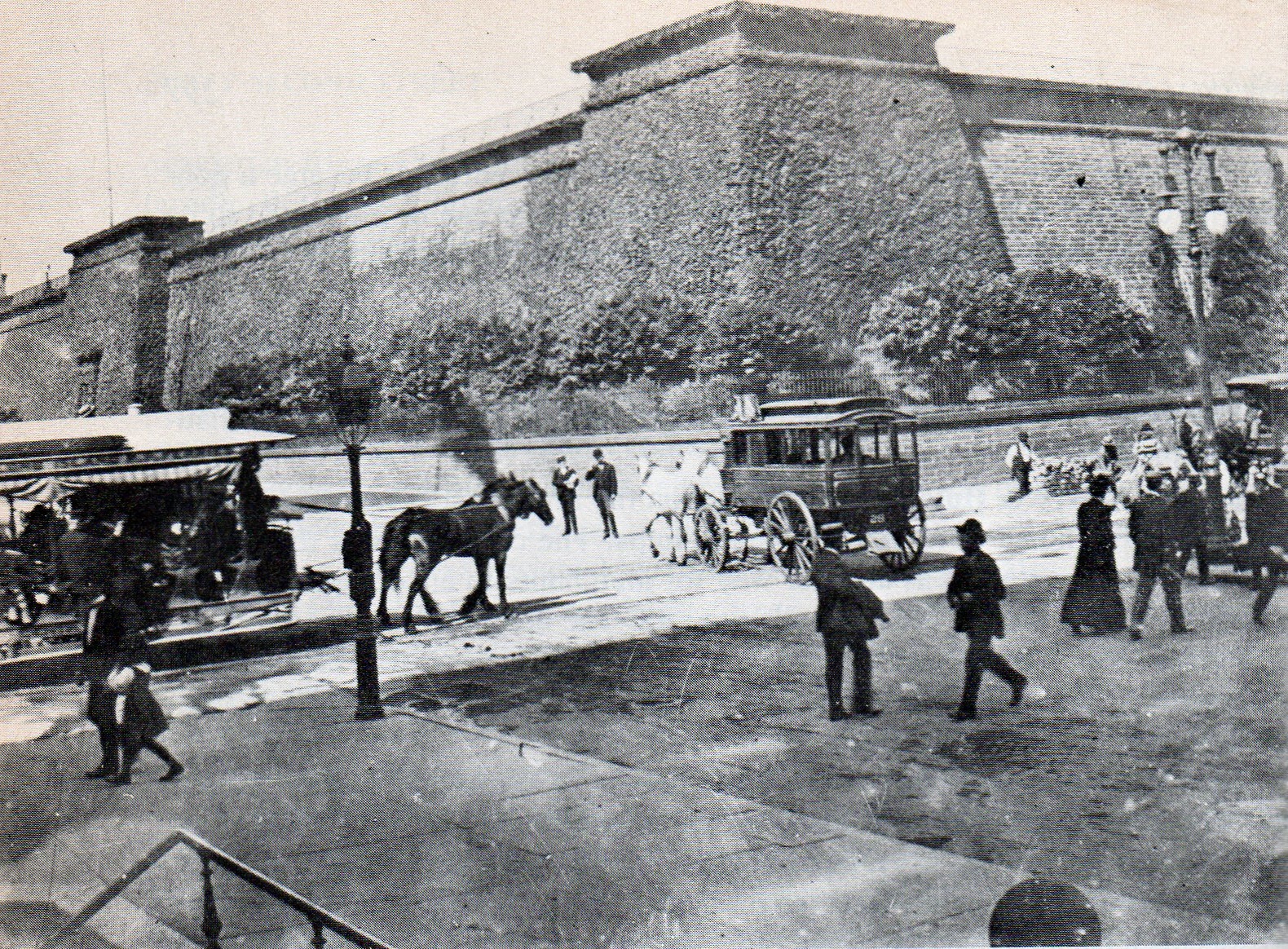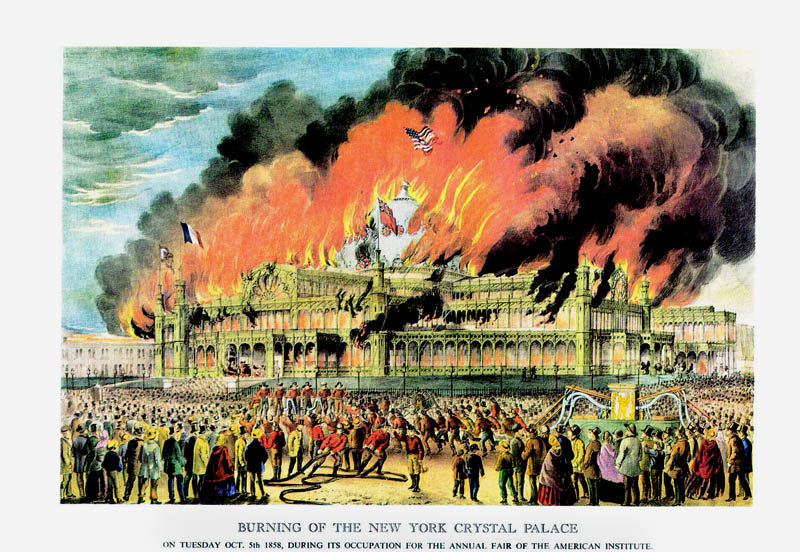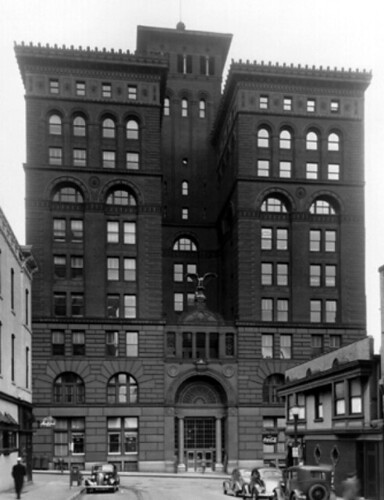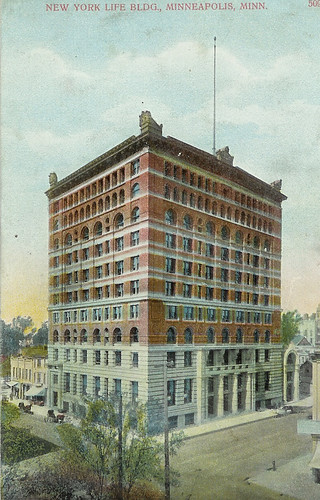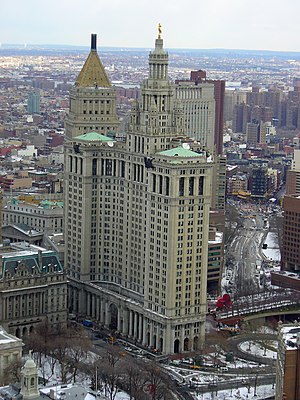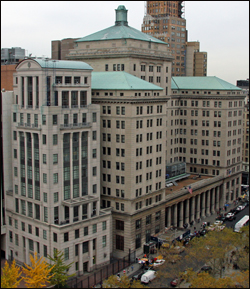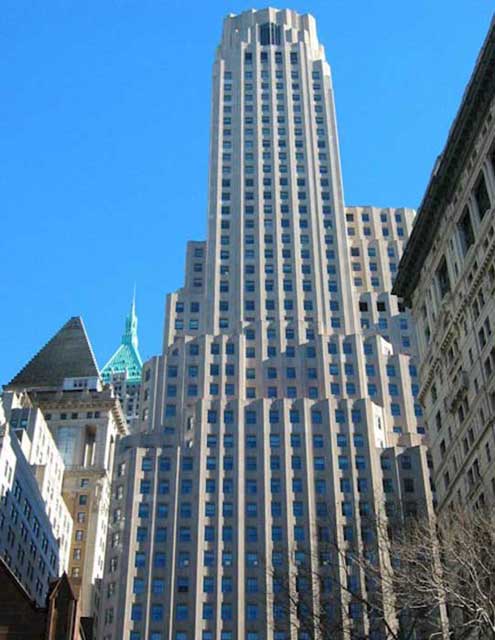NYC has just set a record for the wettest March since records have been kept (back to the mid-nineteenth century). This is annoying in general but has a particularly annoying side effect in my field: wet masonry fails at a higher rate than dry masonry. There have been a series of minor to mid-level wall collapses and similar events.
It's a hard, it's a hard, it's a hard, clay-product rain a gonna fall.
Tuesday, March 30, 2010
Sunday, March 28, 2010
Crystal, Baby
Following the internationally-famous success of the Crystal Palace in London at the 1851 Great Exhibition, several other overgrown greenhouses were built and named "Crystal Palace." New York's was built in 1853 on the current site of Bryant Park. The usual view shows the front of the building, facing Sixth Avenue, which at that time was more of a theory than an actual street.
What never seems to show up in these pictures is the old distributing reservoir for the Croton water system, which was immediately adjacent (at the current site of the public library) and was larger than the Crystal Palace. Here's one corner of it:
In any case, the great technological advance of the construction of exhibition buildings out of wrought iron and glass was that those materials don't burn, so the newfangled buildings were safer.
Of course, in 1858:
London's original made it until 1936 before burning down.
What never seems to show up in these pictures is the old distributing reservoir for the Croton water system, which was immediately adjacent (at the current site of the public library) and was larger than the Crystal Palace. Here's one corner of it:
In any case, the great technological advance of the construction of exhibition buildings out of wrought iron and glass was that those materials don't burn, so the newfangled buildings were safer.
Of course, in 1858:
London's original made it until 1936 before burning down.
Then Tell Me If You're Mute
I've been informed that Google may be screwing up commenting. If you can't comment, leave a comment to tell me.
Saturday, March 27, 2010
The Brooklyn Bridge and Destiny
The Brooklyn Bridge, as has been discussed by people far more scholarly than me and by people with teredo issues has been a cultural icon since it was built. On a personal level I can say that I would probably have drifted into structural engineering even if I had never seen it, but having read about it far more than I should have when I was 16, it was probably inevitable that I would attend Washington Roebling's alma mater.
The question comes up: why is it famous now? It was not the first record-setting long-span suspension bridge (although it did break the existing record by 50%, which is an achievement in any era), it hasn't had the longest span since 1903, and the hypertrophied NYC self-promotion machine has not made the newer and far bigger Verazanno Narrow Bridge famous as anything other than a pain in the ass for people in Staten Island and Brooklyn.
The answer, in my opinion, is a combination of two factors. First, the bridge is beautiful in its structure. There is a small amount of applied ornament - most obviously, the cornices and gothic arches of the towers - but most people who see it in person fixate on the appearance of the cables. Structures that are beautiful in themselves are rare, and this one is in a location that makes it incredibly prominent.
The standard view from the side used for bridges doesn't usually show the Brooklyn Bridge very well as it emphasizes the heavy masonry towers (click on the picture twice for full-size):
A modern high-res photo gives a better idea of the visual effect of the vertical suspender cables and the diagonal brace cables, even with the Manhattan Bridge standing in the background making rabbit ears over the Brooklyn's head (click on the picture twice for full-size):
It's pictures from the walkway that really give the full effect:
The second reason is less visceral but more obscure. The Brooklyn Bridge was completed in 1883 at a critical moment in engineering history. The State of Liberty - the first tall steel frame in the United States - wouldn't be completed until 1886. The first steel-skeleton skyscrapers would be completed in New York and Chicago in 1890. The Brooklyn Bridge was the last large suspension bridge with masonry towers that visually (and in structural analysis) provide a rigid anchor for the flexible cables and deck. We know now, looking back, that this was the both the last of the old-style bridges, with six years devoted to masonry work before the steel superstructure began, and the one of the first demonstrations of the possibilities of steel construction.
But, hey, I just like it.
The question comes up: why is it famous now? It was not the first record-setting long-span suspension bridge (although it did break the existing record by 50%, which is an achievement in any era), it hasn't had the longest span since 1903, and the hypertrophied NYC self-promotion machine has not made the newer and far bigger Verazanno Narrow Bridge famous as anything other than a pain in the ass for people in Staten Island and Brooklyn.
The answer, in my opinion, is a combination of two factors. First, the bridge is beautiful in its structure. There is a small amount of applied ornament - most obviously, the cornices and gothic arches of the towers - but most people who see it in person fixate on the appearance of the cables. Structures that are beautiful in themselves are rare, and this one is in a location that makes it incredibly prominent.
The standard view from the side used for bridges doesn't usually show the Brooklyn Bridge very well as it emphasizes the heavy masonry towers (click on the picture twice for full-size):
A modern high-res photo gives a better idea of the visual effect of the vertical suspender cables and the diagonal brace cables, even with the Manhattan Bridge standing in the background making rabbit ears over the Brooklyn's head (click on the picture twice for full-size):
It's pictures from the walkway that really give the full effect:
The second reason is less visceral but more obscure. The Brooklyn Bridge was completed in 1883 at a critical moment in engineering history. The State of Liberty - the first tall steel frame in the United States - wouldn't be completed until 1886. The first steel-skeleton skyscrapers would be completed in New York and Chicago in 1890. The Brooklyn Bridge was the last large suspension bridge with masonry towers that visually (and in structural analysis) provide a rigid anchor for the flexible cables and deck. We know now, looking back, that this was the both the last of the old-style bridges, with six years devoted to masonry work before the steel superstructure began, and the one of the first demonstrations of the possibilities of steel construction.
But, hey, I just like it.
Wednesday, March 24, 2010
Life in the Burbs
I had to go to Darien, Connecticut, today for a project. Darien is the buckle on CT's WASP belt and I felt swarthier than usual walking down the mostly-sidewalk-free roads.
One incident of note: as I passed a "medical arts" building, I noticed a used rubber glove on the pavement.
One incident of note: as I passed a "medical arts" building, I noticed a used rubber glove on the pavement.
Tuesday, March 23, 2010
Choices
I went to the local burger joint for dinner tonight. It's set up very simply: you walk in, order at the registers, and pay. If you're taking out, they call your name when your order is ready; if you're eating in, they bring the food to your table.
I was there for about fifteen minutes until my take-out order was ready. Two men were standing at the registers, looking at the menu, and debating what to order for that entire time. I heard pieces of the conversation, which included such scintillating debate as whether or not the herbs were spread throughout the meat or simply sprinkled on top. It's a fucking hamburger. A good, well-made, and tasty hamburger, but nothing more. A burger joint with a half-page of burger options is providing a service to both regular customers and obsessive-compulsives.
I've used a variation on this phenomenon at work. If I need a fast response from a client, I give them one or two options. If I want a project to be delayed for a while, I give the client six options or more.
I was there for about fifteen minutes until my take-out order was ready. Two men were standing at the registers, looking at the menu, and debating what to order for that entire time. I heard pieces of the conversation, which included such scintillating debate as whether or not the herbs were spread throughout the meat or simply sprinkled on top. It's a fucking hamburger. A good, well-made, and tasty hamburger, but nothing more. A burger joint with a half-page of burger options is providing a service to both regular customers and obsessive-compulsives.
I've used a variation on this phenomenon at work. If I need a fast response from a client, I give them one or two options. If I want a project to be delayed for a while, I give the client six options or more.
Sunday, March 21, 2010
A Master's Last
Watched Family Plot last night, for the first time since it came out in 1976. Hitchcock's last film, made on a small budget and with some problems in plot and continuity. But there are still a half-dozen "Hitchcock moments" when you sit up and shake your head. My favorite: a kidnapper in his secret cellar lair, hauling an unconscious body...and then the doorbell rings.
Also: the mid-70s. When William Devane, Bruce Dern, and Karen Black were considered good-looking.
Also: the mid-70s. When William Devane, Bruce Dern, and Karen Black were considered good-looking.
Friday, March 19, 2010
The Design Fallacy
First, those looking for the design phallus should check out "Paging Doctor Freud" a few posts down.
Second, a definition: the classic design fallacy concerns appliances. It's when the "artistic" portion of industrial design overwhelms practicality, so that you have a beautiful object that doesn't work properly because of the characteristics that make it beautiful. Olivetti has fallen into this trap a number of times and Bang & Olufsen are often accused of it. I once had a desk with beautiful drawer pulls that were too small for most men's hands, including mine. Looked good, didn't work because of the characteristic that made it look good.
Architects usually avoid the fallacy, but not always. You'll sometimes see handrails that are not easy to grip, for example. My favorite current example is the Gherkin in London, aka 30 St. Mary Axe.
The spiraling mullions are part of the beauty of the design, but they trap dirt. Up close, every intersection of two of those diagonals is marked by a streak of dirt. Oops.
Given the close relationship between engineering and industrial design, it should not be a surprise that "pure" engineering designs sometimes show the fallacy, but it is. Why is it a surprise? Because no one expects engineers to be thinking about aesthetics unless the topic is cars.
Second, a definition: the classic design fallacy concerns appliances. It's when the "artistic" portion of industrial design overwhelms practicality, so that you have a beautiful object that doesn't work properly because of the characteristics that make it beautiful. Olivetti has fallen into this trap a number of times and Bang & Olufsen are often accused of it. I once had a desk with beautiful drawer pulls that were too small for most men's hands, including mine. Looked good, didn't work because of the characteristic that made it look good.
Architects usually avoid the fallacy, but not always. You'll sometimes see handrails that are not easy to grip, for example. My favorite current example is the Gherkin in London, aka 30 St. Mary Axe.
The spiraling mullions are part of the beauty of the design, but they trap dirt. Up close, every intersection of two of those diagonals is marked by a streak of dirt. Oops.
Given the close relationship between engineering and industrial design, it should not be a surprise that "pure" engineering designs sometimes show the fallacy, but it is. Why is it a surprise? Because no one expects engineers to be thinking about aesthetics unless the topic is cars.
Thursday, March 18, 2010
Monty Python
I got the complete Monty Python for my birthday and I'm slowly working my way through it. The architect sketch remains as accurate today as it was the day it was filmed.
Wednesday, March 17, 2010
Architectural Colonialism 2
Say, for the sake of argument, that you're an executive at New York Life Insurance in 1890, when your company is busy expanding your national presence. Instead of renting space for your regional offices, you're planning on building your own. What do you do to make it clear that the new building belongs to your company, the big bad New Yorkers?
The answer is obvious: you build New York-style skyscrapers* wherever you go.
Kansas City, 1890
St. Paul, 1890
Omaha, 1890
Minneapolis, 1890
Bigger and fancier buildings were built in Chicago in 1894 and New York in 1895 (this a third expansion of the existing headquarters), but these were simply individual tall buildings in two cities crowded with them. On the other hand, the Kansas City and Omaha buildings were the tallest in their respective citites when built, the Minneapolis building was one of three in the city taller than 10 stories, the St. Paul building was one of four in the city taller than 10 stories.
NY Life to the Midwest: HERE WE ARE!
*"Skyscraper" is a term without a fixed meaning. In the 1890s, a ten-story steel-frame building arguably qualified.
The answer is obvious: you build New York-style skyscrapers* wherever you go.
Kansas City, 1890
St. Paul, 1890
Omaha, 1890
Minneapolis, 1890
Bigger and fancier buildings were built in Chicago in 1894 and New York in 1895 (this a third expansion of the existing headquarters), but these were simply individual tall buildings in two cities crowded with them. On the other hand, the Kansas City and Omaha buildings were the tallest in their respective citites when built, the Minneapolis building was one of three in the city taller than 10 stories, the St. Paul building was one of four in the city taller than 10 stories.
NY Life to the Midwest: HERE WE ARE!
*"Skyscraper" is a term without a fixed meaning. In the 1890s, a ten-story steel-frame building arguably qualified.
Tuesday, March 16, 2010
Architectural Colonialism 1
The city of Greater New York was created in 1898 when the cities of New York (and its existing absorbed suburbia in the Bronx) and Brooklyn, various towns in (the west half of the old) Queens County, and the farmland and villages of Richmond County merged. Even though Manhattan had less than half the total population, it was running the show, and local autonomy mostly disappeared never to return.
Brooklyn's city hall was renamed "Borough Hall" in a preliminary act of New York superiority. The real offense came later. The nineteenth-century city hall buildings were too small for modern bureaucracy and office buildings were built, first in Manhattan and then in Brooklyn.
Manhattan's Municipal Building, completed in 1915:
Brooklyn's Municipal Building, completed in 1924:
M to B: You get one just like ours, only smaller!
Brooklyn's city hall was renamed "Borough Hall" in a preliminary act of New York superiority. The real offense came later. The nineteenth-century city hall buildings were too small for modern bureaucracy and office buildings were built, first in Manhattan and then in Brooklyn.
Manhattan's Municipal Building, completed in 1915:
Brooklyn's Municipal Building, completed in 1924:
M to B: You get one just like ours, only smaller!
Random Political Factoid
Lee Papa, aka The Rude Pundit, teaches at the College of Staten Island. So when he's not writing scatological political humor, he's forcing guidos to read plays they don't like.
Monday, March 15, 2010
Paging Dr. Freud
If I'm going to discuss tall buildings, might as well get this out of the way. Skyscrapers are not penises unless you have a very strange definition of "penis." Most have flat tops and rectangular footprints, many of the remainder have spires ending in points. (Everyone together now: ouch.)
Except, of course that some are. The current champion, in my opinion, is the Williamsburg Bank on Flatbush Avenue in Brooklyn. Tallest building in Brooklyn from the late 1920s until last year and a big old dick:
The a/c equipment for the building is under the dome, and in cold weather it vents steam...you get the idea.
The all-time champion was the Singer Building, the headquarters of the sewing-machine company, which was demolished for a rather boring black steel-and-glass building. It had a large base with a curved mansard roof, a 65-foot square tower, and then another curved mansard on top of the tower.
Singer, in its rampant glory:
Except, of course that some are. The current champion, in my opinion, is the Williamsburg Bank on Flatbush Avenue in Brooklyn. Tallest building in Brooklyn from the late 1920s until last year and a big old dick:
The a/c equipment for the building is under the dome, and in cold weather it vents steam...you get the idea.
The all-time champion was the Singer Building, the headquarters of the sewing-machine company, which was demolished for a rather boring black steel-and-glass building. It had a large base with a curved mansard roof, a 65-foot square tower, and then another curved mansard on top of the tower.
Singer, in its rampant glory:
One Wall Street
I fell off this building in 1988 while conducting a facade survey. Safety harnesses are wonderful things.
Thinking like an Engineer
I was walking down a side street, minding my own business as much as that's actually possible in Manhattan, when I saw a young woman struggling to open the door to an office building.* The door was one of a pair of heavy glass doors with no frame, just hidden hinges; she was quite small and - important to note - wearing spike heels.
A lot of commercial building doors have stiff hinges. It's a combination of design (the doors won't accidentally swing open from wind or the difference in pressure between inside and out) and accident (the hinges are never cleaned). The woman pulled normally at first (standing vertically with her arm parallel to the ground), the way one would with an interior door, and nothing happened. Then she simultaneously pulled and leaned back slightly, and still nothing happened.
This is where the narrative switches to geek-speak because I switched to geek-think. She was approaching the problem as one of applying a force to the door, but that wasn't the problem. She needed to balance the force she was trying to apply with her arm and (by leaning back) upper body with a reaction to the ground. Her feet needed to be pushing towards the door with as much force as her arm was pulling, and her shoes made it nearly impossible: the configuration of the human body is such that we push forward with our heels, as in "digging your heels in." There was no way for her to do so on shoe heels that were probably under 1/4 square inch in area. On the other hand, if the door was set up to swing in, she could have pushed back off the balls of her feet and her toes to push forward with her arm.
I suspect that all women who regularly wear spike-heeled shoes understand this from experience, but I've never heard it discussed. As someone with large and partially flat feet, I take the reactive force for granted almost all the time. And, it can be endlessly fun demonstrating Newton's Third Law to people while ice skating.
*I might have been inspired to play Galahad, but a woman leaving the building pushed it open from inside before I was near enough to consider breaking stride to help.
A lot of commercial building doors have stiff hinges. It's a combination of design (the doors won't accidentally swing open from wind or the difference in pressure between inside and out) and accident (the hinges are never cleaned). The woman pulled normally at first (standing vertically with her arm parallel to the ground), the way one would with an interior door, and nothing happened. Then she simultaneously pulled and leaned back slightly, and still nothing happened.
This is where the narrative switches to geek-speak because I switched to geek-think. She was approaching the problem as one of applying a force to the door, but that wasn't the problem. She needed to balance the force she was trying to apply with her arm and (by leaning back) upper body with a reaction to the ground. Her feet needed to be pushing towards the door with as much force as her arm was pulling, and her shoes made it nearly impossible: the configuration of the human body is such that we push forward with our heels, as in "digging your heels in." There was no way for her to do so on shoe heels that were probably under 1/4 square inch in area. On the other hand, if the door was set up to swing in, she could have pushed back off the balls of her feet and her toes to push forward with her arm.
I suspect that all women who regularly wear spike-heeled shoes understand this from experience, but I've never heard it discussed. As someone with large and partially flat feet, I take the reactive force for granted almost all the time. And, it can be endlessly fun demonstrating Newton's Third Law to people while ice skating.
*I might have been inspired to play Galahad, but a woman leaving the building pushed it open from inside before I was near enough to consider breaking stride to help.
Subscribe to:
Posts (Atom)

